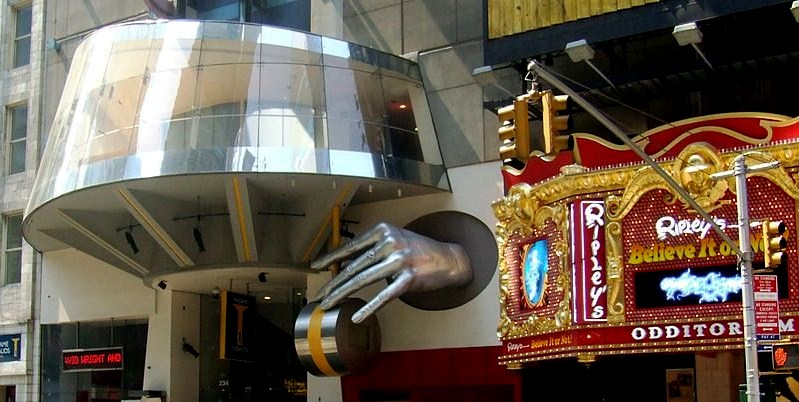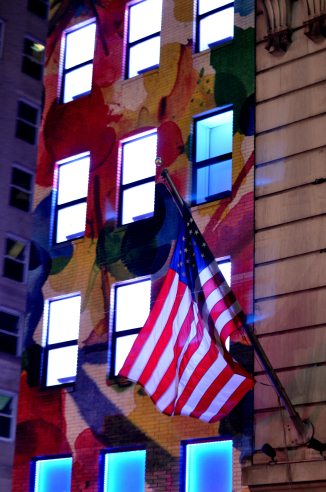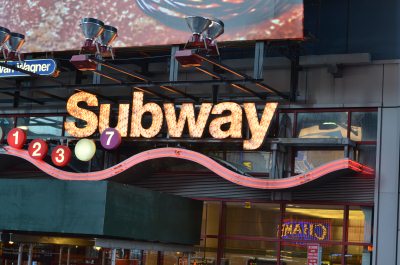|
Times Square
Times
Square is a major commercial intersection in the borough of
Manhattan, at the
junction of Broadway and Seventh Avenue and stretching from West 42nd to West 47th
Streets. The extended Times Square area, also called the Theatre
District, consists of the blocks between Sixth and Eighth Avenues from east to west, and West 40th and West 53rd Streets from
south to north, making up the western part of the commercial area of Midtown
Manhattan. Formerly named
Longacre Square, Times Square was renamed in April 1904 after The New York Times
moved
its headquarters to the newly erected Times Building, which is now called One
Times Square and is the site of the annual ball drop on New Year's
Eve. Times Square, nicknamed "The Crossroads of the World" and "The Great
White Way," has
achieved the status of an iconic world landmark and is a symbol of New York City
and the United States.
 
Broadway at 42nd
Street in 1880. 1921 a crowd outside
The New York Times follow the progress of the Jack Dempsey-Georges
Carpentier fight
History: Before and after the American
Revolution, the area
belonged to John Morin Scott, a general of the New York militia where he served
under George Washington. Scott's manor house was at what is now
43rd Street, surrounded by countryside used for farming and breeding horses. In
the first half of the 19th century it became one of the prized possessions of
John Jacob Astor, who made a second
fortune selling off lots to hotels and other real estate concerns as the city rapidly spread uptown. In 1904, New York
Times publisher Adolph
S. Ochs moved the newspaper's operations to a new
skyscraper on 42nd Street at Longacre Square. Ochs persuaded Mayor George B. McClellan, Jr to construct
a subway station there, and the area was renamed "Times Square" on the 8th of
April 1904. Just three weeks later, the first electrified
advertisement appeared on the
side of a bank at the corner of 46th Street and Broadway. The New York
Times, according to
Nolan, moved to more spacious offices across Broadway in
1913.
Also in 1913, the Lincoln Highway Association, headed by entrepreneur
Carl G. Fisher, chose the intersection of 42nd Street and Broadway, at the
southeast corner of Times Square, to be the Eastern Terminus of the Lincoln
Highway, the first road across the United States, which originally spanned
3,389 miles coast-to-coast through 13 states to its Western Terminus in
Lincoln Park in San Francisco, California. As the growth in New York City continued, Times
Square quickly became a cultural hub full of theaters, music halls and upscale hotels. Times Square quickly became New York's
agora, a place to gather to await
great tidings and to celebrate them, whether a World Series or a presidential
election - James Traub, The Devil's Playground: A Century of Pleasure and
Profit in Times Square.
The Naked Cowboy (who actually wears
knickers is very popular with the tourists.
Celebrities such as Irving Berlin, Fred Astaire and
Charlie Chaplin were closely
associated with Times Square in the 1910's and 1920's. During this period, the
area was nicknamed The Tenderloin because
it was supposedly the most desirable location in Manhattan. However, it was during this period that the area was besieged by
crime and corruption, in the form of gambling and prostitution; one case that garnered huge attention was the arrest and subsequent
execution of police officer Charles Becker. (Bear asked for Charles to have his own blog). The general atmosphere changed with the onset of
the Great Depression in the 1930's. Times Square acquired a reputation as a dangerous
neighbourhood in the following
decades. From the 1960's to the early 1990's, the seediness of the area,
especially due its go-go bars, sex
shops and adult
theatres, became an infamous
symbol of the city's
decline. In the 1980's, a commercial building boom began in the western
parts of the Midtown as part of a long-term development plan developed under Mayor Ed Koch and David Dinkins. In the mid-1990s,
Mayor Rudolph Giuliani (1994-2002) led an effort to "clean up" the area, increasing
security, closing pornographic
theatres, pressuring drug dealers and "squeegee men" to relocate, and opening more tourist-friendly attractions and upscale establishments. Advocates of the remodeling claim that the neighborhood is safer and cleaner. Detractors have
countered that the changes have homogenized or "Disneyfied" the character of Times Square and have unfairly
targeted lower-income New Yorkers from nearby neighborhoods such as Hell's
Kitchen. In 1990, the state of
New York took possession of six of the nine historic theatres on 42nd Street,
and the New 42nd Street non-profit organisation was appointed to oversee their restoration and maintenance. The
theatres underwent renovation for Broadway shows, conversion for commercial
purposes, or demolition.

Madame Tussauds Wax Museum and Ripleys Believe It or
Not are two of the newer attractions on the redeveloped 42nd
Street
Times Square Today: The theatres of Broadway and the
huge number of animated neon and LED signs have long made them one of New York's
iconic images, and a symbol of the intensely urban aspects of Manhattan. Times
Square is the only neighborhood with zoning ordinances requiring building owners
to display illuminated signs. The density of illuminated signs in
Times Square now rivals that of Las Vegas. Officially, signs in Times Square are
called "spectaculars", and the largest of them are called
"jumbotrons." Times Square's first environmentally friendly
billboard powered by wind and solar energy was first lit on the 4th of December
2008. In 1992, the Times Square
Alliance (formerly the Times Square Business Improvement District, or "BID" for short), a coalition of city
government and local businesses dedicated to improving the quality of commerce
and cleanliness in the district, started operations in the area.
  
Times Square now boasts attractions such as ABC's Times Square
Studios, where Good Morning America
is broadcast live, an elaborate Toys R Us store, and competing Hershey's and M&M's stores across the street from each other, as
well as restaurants such as Ruby Foo's (Chinese food), the Bubba Gump Shrimp Company (seafood), Planet
Hollywood and Carmine's
(Italian) along with a number of
multiplex movie theaters. It has also attracted a number of large financial,
publishing, and media firms to set up headquarters in the area. A larger
presence of police has improved the safety of the area. From the 14th to the 15th of August 2003,
the lights of Times Square went dark as a result of the 2003 Northeast
Blackout, which paralysed most of
the region and parts of Canada for over 24 hours. On the morning of the 6th of March 2008 a
small bomb caused minor damage but
no reported injuries. On the 26th
of February 2009, Mayor Michael Bloomberg announced that traffic lanes along Broadway from 42nd Street to 47th Street would be de-mapped starting Memorial Day 2009
and transformed into pedestrian plazas until at least the end of the year as a
trial. The same was done from 33rd to 35th Street. The goal is to ease traffic
congestion throughout the Midtown grid. The results will be closely monitored to
determine if the project works and should be extended." Bloomberg also stated
that he believes the street shutdown will make New York more livable by reducing
pollution, cutting down on pedestrian accidents and helping traffic flow more
smoothly. The original seats put
out for pedestrians were inexpensive multicolored plastic lawn chairs, a source
of amusement to many New Yorkers. They lasted from the onset of the plaza
transformation until the 14th of August 2009, when they were ceremoniously
bundled together in an installation christened "Now You See It, Now You Don't"
by the artist Jason Peters. They were shortly replaced by sturdier metal
furniture, and on the 11th of February 2010, Mayor Michael Bloomberg
announced that the pedestrian plazas would remain permanent. In February 2011, Times Square became smoke free
as New York extended the outdoors smoking ban to the area. The measure will see smokers fined $50 if they light
up.
 
New Year's Eve 2007. People await the
ball drop
New Year's Eve: Times Square is the site of
the annual New Year's Eve Ball Drop. On the 31st of December 1907, a ball signifying New Year's
Day was first dropped at Times
Square and the Square has held the main New Year's celebration in New York City
ever since. On that night, hundreds of thousands of people congregated to watch
the Waterford Crystal ball being
lowered on a pole atop the building, marking the start of the new year. It
replaced a lavish fireworks display from the top of the building that was held
from 1904 to 1906, but stopped by city officials because of the danger of fire.
Beginning in 1908 and for more than eighty years thereafter, Times Square sign
maker Artkraft Strauss
was responsible for the ball-lowering. During World War II, a minute of silence,
followed by a recording of church bells pealing, replaced the ball drop because
of wartime blackout restrictions. Today, Countdown Entertainment and One Times
Square handle the New Year's Eve event in conjunction with the Times Square
Alliance. In 2002, New York City's mayor,
Rudy Giuliani, gave the oath of
office to the city's next mayor, Michael Bloomberg, at Times Square after midnight on the 1st of January
as part of the 2001–2002 New Year's celebration. Approximately 500,000
revelers attended. Security was high following the 9/11 2001 terrorist
attacks, with more than 7,000 New
York police officers on duty in the
Square, twice the number for an ordinary year. A new energy-efficient LED ball, celebrating the
centennial of the ball drop,
debuted for the arrival of 2008. The 2008/2009-ball, which was dropped on New
Year's Eve 2008 for the arrival of 2009, is larger and has become a
permanent installation as a year-round attraction, being used for celebrations
such as Valentine's Day and Halloween. On average, about 1 million revelers
crowd Times Square for the New Year's Eve celebrations. However, for the
millennium celebration, published reports stated approximately two million
people overflowed Times Square, flowing from 6th Avenue to 8th Avenue and all
the way back on Broadway and Seventh Avenues to 59th Street, making it the
largest gathering in Times Square since August 1945 during the celebrations
marking the end of World War II.

ALL IN ALL THE HEART OF NEW
YORK
|

















